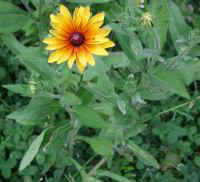 Orange
Coneflower (Rudbeckia fulgida)
Orange
Coneflower (Rudbeckia fulgida)
Wild Flowers of Sleepy Hollow Lake From All-Creatures.org Art and Photo Journals and Galleries Directory
Dedicated to the Preservation and Restoration of the Whole of Creation: Humans - Animals - Environment
"And God saw all that He had made, and behold, it was very good.
And there was evening and there was morning, the sixth day" (Genesis 1:31)
Orange Coneflower (Rudbeckia fulgida)
Table of Contents

(Orange Coneflower (Rudbeckia fulgida) - 01)
The orange coneflower is closely related to the black-eyed Susan, and we have
found considerable confusion in the naming of this species. After
considerable research, we have concluded that the orange coneflower, Rudbeckia
fulgida, must have the orange coloration at the base of the ray flowers,
otherwise it is another variety of the black-eyed Susan. Some of the
photos we looked at on the Internet had less orange coloration than this one,
but it was still evident.

(Orange Coneflower (Rudbeckia fulgida) - 02)
This side view of the orange coneflower gives us a good look at the rising brown
disk in the center. Also note the hairy stem.

(Orange Coneflower (Rudbeckia fulgida) - 03)
The leaves of the orange coneflower are linear-elliptical in shape, slightly
toothed, and hairy on the underside. We have observed that some leaves on
the same plant show very little or no noticeable toothing.

(Orange Coneflower (Rudbeckia fulgida) - 03a)
In this photo of the orange coneflower, we can see that the leaves grow
alternately along the stem, and that the flower sepals are also hairy.

(Orange Coneflower (Rudbeckia fulgida) - 04)
This is a close up look at the 1-1/2 inch diameter orange coneflower.
According to the literature, the number of ray flowers can vary considerably
from the more than 20 in this flower to as few as 8.

(Orange Coneflower (Rudbeckia fulgida) - 05)
In this bee's eye view of the center of an orange coneflower, we have a good
view of the disk flowers and the orange pigmented portion of the ray flowers.

(Orange Coneflower (Rudbeckia fulgida) - 06)
In this view of the underside of the flower of the orange coneflower, we can see the
hairiness of the stem and fully opened sepals. Also note that the orange
coloration of the ray flowers is not as pronounced when viewed from below.

(Orange Coneflower (Rudbeckia fulgida) - 07)
In this photo of the orange coneflower, we can compare its size to that of an
ox-eyed daisy. The orange coneflower is a member of the Composite Family,
Compositae (older naming), or Aster Family, Asteraceae.

(Orange Coneflower (Rudbeckia fulgida) - 08)
This is another close up look at the beauty of the orange coneflower.

(Orange Coneflower (Rudbeckia fulgida) - 09)
Another thing we have observed about the orange coneflower is that the leaves
grow upward from the stem, with only the more mature leaves leaning downward
toward the horizontal. The flower stems emerge from the leaf axils.

(Orange Coneflower (Rudbeckia fulgida) - 10)
This is a close up look at an orange coneflower bud that is just beginning to open.

(Orange Coneflower (Rudbeckia fulgida) - 11)
This is a bee's eye view of the center of an orange coneflower bud that is just
beginning to open. Note that at this stage of development the ray flowers are also hairy.
| Wild Flowers of SHL: Photo Identification, Common Name, Scientific Name | Art and Photos |

 Presented here are just a few of the countless components of God's creation.
Just as we cannot have human and animal life without water and plants, neither
can we have lasting peace without love and compassion. It is our hope and
prayer that this series will motivate people to live and act in a cruelty-free
manner; that we would no longer hurt or destroy each other, the animals or our
environment.
Presented here are just a few of the countless components of God's creation.
Just as we cannot have human and animal life without water and plants, neither
can we have lasting peace without love and compassion. It is our hope and
prayer that this series will motivate people to live and act in a cruelty-free
manner; that we would no longer hurt or destroy each other, the animals or our
environment.






